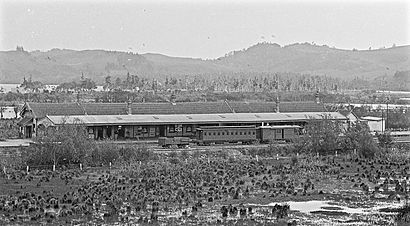Mercer railway station facts for kids
Quick facts for kids
Mercer railway station
|
|
|---|---|

1910 Mercer station viewed from east with Waikato River in middle distance.
Price, William Archer, 1866–1948 Collection of post card negatives. Ref: 1/2-001041-G. Alexander Turnbull Library, Wellington |
|
| Location | Mercer New Zealand |
| Coordinates | 37°16′39″S 175°02′52″E / 37.27750°S 175.04778°E |
| Owned by | KiwiRail Network |
| Line(s) | North Island Main Trunk |
| Tracks | double track from 11 November 1951 |
| History | |
| Opened | 20 May 1875 |
| Closed | 1986 |
The Mercer railway station is located in Mercer, New Zealand. It is an important stop on the North Island Main Trunk railway line. This line connects major cities in New Zealand. The station is about 72 kilometers (45 miles) from Auckland. It is also 609 kilometers (378 miles) from Wellington.
Mercer station first opened on May 20, 1875. It stopped serving passengers around 1970. Goods trains continued to use it until the 1990s. Sadly, the station building burnt down twice. It was destroyed by fire in 1879 and again in 1900. For many years, until 1958, Mercer was the first place south of Auckland where trains would stop for refreshments.
| Preceding station | Following station | |||
|---|---|---|---|---|
| Pokeno Line open, station closed |
North Island Main Trunk New Zealand Railways Department |
Amokura Line open, station closed |
||
Contents
Station History
Early Days and Opening
The railway line reached Mercer on May 20, 1875. Before this, a special train ran the day before. It was for an excursion organized by the British builders, John Brogden & Sons. The New Zealand Herald newspaper said Mercer would be a very busy station. This was because it was the end of the line for a while.
The newspaper also described the journey. It mentioned crossing the Mangatawhiri swamp. The line then ran next to the South Road. A short branch line was also built. This connected the railway to boats on the Waikato River. At the time of opening, the station buildings were still being finished.
Mercer as a Terminus
Mercer was the end of the line for just over two years. The railway line was then extended further south. It reached Ngāruawāhia on August 13, 1877. This meant Mercer was no longer the final stop.
A special room for refreshments was built in 1876-1877. It cost £245. This room was made bigger in 1878-1879 for another £180. When the railway first opened, the station was not fully ready.
In 1880, an advertisement announced the reopening of the refreshment rooms. It said that trains would wait for 20 minutes at Mercer. This gave passengers time to get food and drinks.
Station Facilities and Staff
After being rebuilt in 1902, the station was described in detail. It was a long building made of wood and iron. Inside, it had a large refreshment room and a bar. There was also a ladies' room and a public room. Other areas included a booking office and the stationmaster's room. A post and telegraph office was also part of the station.
Outside, there was a large shed for engines. There was also a pump house and a coal shed. Nine staff members worked at the station. These included a stationmaster, a porter, and a cadet. There were also two engine drivers, two firemen, and two greasers.
Refreshment Rooms and Wartime Importance
The refreshment rooms were managed by the Mercer Railway Hotel. This hotel was located right across from the station. This continued until 1917. That year, the New Zealand Railways took over the management. The hotel itself was rebuilt in 1898. It had 15 bedrooms, three sitting rooms, and a dining room for 50 people.
The refreshment rooms became even more important during World War II. This was because dining cars were removed from main express trains. This was a measure taken during the war. Passengers then relied on station stops like Mercer for their meals.
Traffic at Mercer station grew a lot during World War 2. Many people traveled by train during this time.
Future Plans
In 2011, a report looked into bringing back passenger train services to Mercer. The report suggested building a new platform. It would be 155 meters (508 feet) long and 750 millimeters (30 inches) high. This would be suitable for trains with six carriages. The estimated cost for this was $4 million. However, the idea was put on hold. Some people believe the cost was made too high to stop the project.
Images for kids


